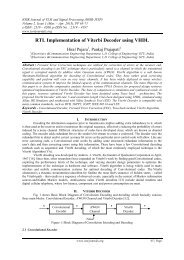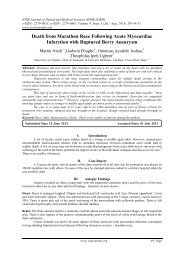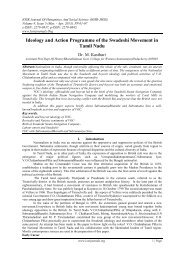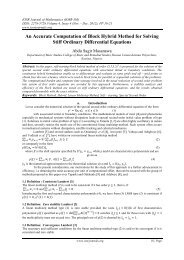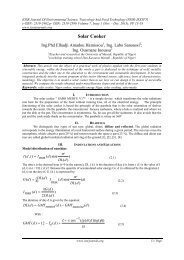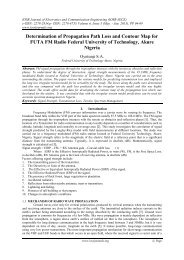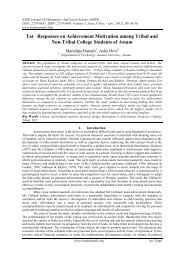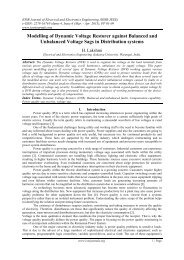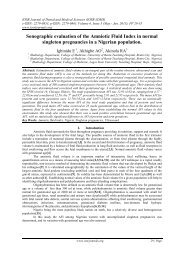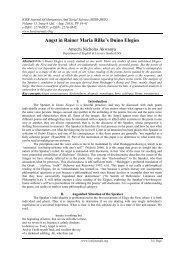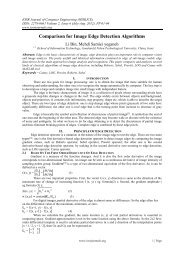Design Compatibility of Classroom Furniture in Urban and ... - IOSR
Design Compatibility of Classroom Furniture in Urban and ... - IOSR
Design Compatibility of Classroom Furniture in Urban and ... - IOSR
You also want an ePaper? Increase the reach of your titles
YUMPU automatically turns print PDFs into web optimized ePapers that Google loves.
The Impact Of Corporate Governance And Leadership On Entrepreneurship Development In Nigeria<br />
<strong>in</strong> tables which show the response <strong>in</strong> percentage. The data collected are presented <strong>and</strong> analyzed below so as to<br />
have a better underst<strong>and</strong><strong>in</strong>g <strong>of</strong> the impacts <strong>of</strong> leadership <strong>and</strong> corporate governance on the bank<strong>in</strong>g <strong>in</strong>dustry<br />
entrepreneurship development.<br />
4.1 RESPONDENTS’ CHARACTERISTICS AND CLASSIFICATION<br />
The respondents‟ characteristics <strong>and</strong> classification as presented <strong>in</strong> section „A‟ <strong>of</strong> this research work<br />
which st<strong>and</strong>s as the personal data <strong>of</strong> the respondents are stated below:<br />
Table 1: Sex distribution <strong>of</strong> respondents<br />
Respondent No <strong>of</strong> respondents % <strong>of</strong> respondents<br />
Male 52 52<br />
Female 48 48<br />
Total 100 100<br />
Source: Author‟s computation 2012<br />
Table 1 above <strong>in</strong>dicates that 52 or 52% <strong>of</strong> the total number <strong>of</strong> the respondents sampled were male which<br />
represents the majority, while 48 or 48% were female. This implies that the number <strong>of</strong> male <strong>in</strong> these<br />
organizations were more than their female counterpart.<br />
Table 2: Age distribution <strong>of</strong> the respondents<br />
Respondent No <strong>of</strong> respondents % <strong>of</strong> respondents<br />
21-30yrs 38 38<br />
31-40yrs 31 31<br />
41-50yrs 23 23<br />
51-60yrs 6 6<br />
61yrs & above 2 2<br />
Total 100 100<br />
Source: Author‟s computation 2012<br />
Table 2 above shows that out <strong>of</strong> the total population <strong>of</strong> the respondents, majority with a total number <strong>of</strong><br />
38 or 38% were with <strong>in</strong> the age bracket <strong>of</strong> 21-30years, 31 or 31% were with<strong>in</strong> the age bracket <strong>of</strong> 31-40 years, 23<br />
or 23% were with<strong>in</strong> the age bracket <strong>of</strong> 41-50years, 6 or 6% were with<strong>in</strong> the age bracket <strong>of</strong> 50-60years, while 2<br />
or 2% were with<strong>in</strong> the age bracket <strong>of</strong> 61 years <strong>and</strong> above. From the above analysis, it could be <strong>in</strong>ferred that<br />
majority <strong>of</strong> the respondents were still young, agile, productive <strong>and</strong> mobile to run the affairs <strong>of</strong> these<br />
organizations effectively.<br />
Table 3: Marital status <strong>of</strong> the respondents<br />
Respondent No <strong>of</strong> respondents % <strong>of</strong> respondents<br />
S<strong>in</strong>gle 42 42<br />
Married 56 56<br />
Divorced 02 02<br />
Widow (er) - -<br />
Total 100 100<br />
Source: Author‟s computation 2012<br />
Table 3 above shows that a total <strong>of</strong> 42 or 42% <strong>of</strong> the respondents were s<strong>in</strong>gle, 56 or 56% were married,<br />
2 or 2% were divorced, while none was widow(er). This is to say that, majority <strong>of</strong> the respondents are married,<br />
which means that they are responsible people.<br />
Table 4: Educational Qualification <strong>of</strong> the respondents<br />
Respondent No <strong>of</strong> respondents % <strong>of</strong> respondents<br />
ND/NCE 23 23<br />
HND/B.Sc 41 41<br />
MBA/M.Sc 30 30<br />
Others 6 6<br />
Total 100 100<br />
Source: Author‟s computation 2012<br />
Table 4 above which portrayed educational qualification <strong>of</strong> the sampled population reveals that, a total <strong>of</strong> 23 or<br />
23% <strong>of</strong> the respondents were ND/NCE holder, 41 or 41% were HND/B.Sc Certificate holder, 30 or 30% were<br />
www.iosrjournals.org<br />
57 | Page



